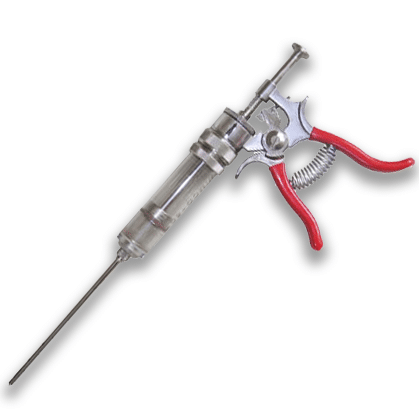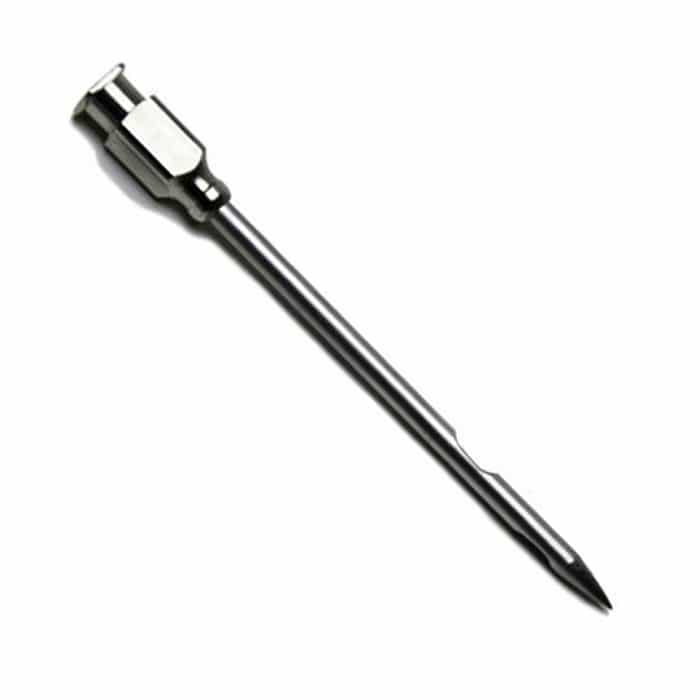While most marinades fall short when it comes to delivering flavor deep inside beef, pork, and poultry, these injection recipes really get the job done.
First of all, mix your injection in a non-reactive container.
When I inject I shoot for a brine that is about 2 to 4% salt by weight. I use Morton Coarse Kosher Salt. Remember, it is a different salinity than table salt or most other salts, even other kosher salts. It will diffuse to a lower concentration within the meat, enough to enhance flavor and bind water, but not enough to give the meat a cured flavor. Here is the math: Morton Coarse Kosher Salt weighs 15 grams/Tablespoon. The recipes below call for 2 Tablespoons Morton Coarse Kosher Salt or 30 grams total. 1 quart of water weighs 944 grams. 30/944 = 3.2%. Note that the Worcestershire has salt in it, so the final injection is probably closer to 3.5%.
If I add flavor, I try not to go crazy. You can add oils, herbs, spices, sweeteners, syrups, sauces, stocks, broths, colorings, pretty much anything. Fresh papaya or pineapple juice (not canned or bottled) have enzymes that tenderize. But be thoughtful. Do you really want your turkey to taste like Dr. Pepper? If you use herbs or spices, grind them fine. Don’t use dark liquids like soy sauce or Worcestershire on light colored meats like chicken or turkey. Don’t go crazy with sweeteners. Here are the recipes I use. To inject, we like heavy duty reusable injectors such as this Spitjack 2-ounce Injector Gun.
Makes:
Takes:
Ingredients
Pork Brine Injection
- 2 tablespoons Morton Coarse Kosher Salt
- 1 tablespoon sugar
- 1 tablespoon Worcestershire
- 2 tablespoons rice vinegar
- 1 cup apple juice or low sodium pork, chicken, or beef stock
- 3 cups water
Red Meat Brine Injection
- 2 tablespoons Morton Coarse Kosher Salt
- 1 tablespoon sugar
- 2 teaspoons Worcestershire
- 4 cups water or low sodium beef stock, or a mix of both
Poultry Brine Injection
- 2 tablespoons Morton Coarse Kosher Salt
- 1 tablespoon sugar
- 4 cups water or low sodium chicken stock, or a mix of both
These recipes were created in US Customary measurements and the conversion to metric is being done by calculations. They should be accurate, but it is possible there could be an error. If you find one, please let us know in the comments at the bottom of the page
Method
- Prep. Mix all the ingredients in a bottle and shake vigorously before injecting. Pour into a narrow container so you can suck fluid in through the needle. In a wide bowl it is hard to get the holes below the water line and you then need to unscrew the top, pour it into the syringes, spill it everywhere, screw on the top, inject, and repeat. I bought a V-shaped flower vase for the job.
- Inject. Insert the needle and go all the way to the center. Press the plunger slowly and ease the needle out. Insert the needle about every 1.5" (38.1 mm) apart and leave behind about 1 ounce (30 mL) per pound (453.6 grams). A little liquid will follow the needle out of the hole, but if it comes spurting out, use less pressure. We want to avoid pockets of liquid.
- Cook. You can cook right away, but if you let the meat rest for an hour or more, even overnight, the injection will disperse more evenly through the meat. Then dry the surface with a paper towel and apply your rub and cook.




High quality websites are expensive to run. If you help us, we’ll pay you back bigtime with an ad-free experience and a lot of freebies!
Millions come to AmazingRibs.com every month for high quality tested recipes, tips on technique, science, mythbusting, product reviews, and inspiration. But it is expensive to run a website with more than 2,000 pages and we don’t have a big corporate partner to subsidize us.
Our most important source of sustenance is people who join our Pitmaster Club. But please don’t think of it as a donation. Members get MANY great benefits. We block all third-party ads, we give members free ebooks, magazines, interviews, webinars, more recipes, a monthly sweepstakes with prizes worth up to $2,000, discounts on products, and best of all a community of like-minded cooks free of flame wars. Click below to see all the benefits, take a free 30 day trial, and help keep this site alive.
Post comments and questions below
1) Please try the search box at the top of every page before you ask for help.
2) Try to post your question to the appropriate page.
3) Tell us everything we need to know to help such as the type of cooker and thermometer. Dial thermometers are often off by as much as 50°F so if you are not using a good digital thermometer we probably can’t help you with time and temp questions. Please read this article about thermometers.
4) If you are a member of the Pitmaster Club, your comments login is probably different.
5) Posts with links in them may not appear immediately.
Moderators